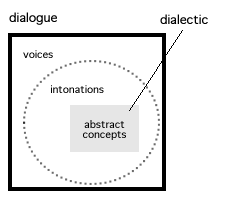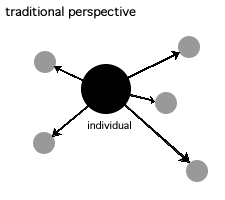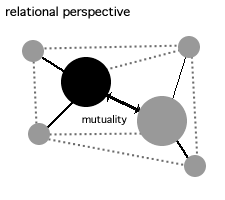The notion of user experience has evolved from ideal isolation of a person interacting with a tool to a context-sensitive relationship that is unique to the participants (human and machine) involved. Many in HCI are now aware of this phenomenological bent and are adjusting design philosophy to match, but there hasn’t been much consideration yet to how a relational perspective further changes design.
Dialogical Technology
Experience is discussed in McCarthy and Wright’s Technology As Experience (2004), covering a journey of academic philosophy from rationalism to practice and the pragmatist views of John Dewey and Mikhail Bakhtin. The most interesting part for me was the section on technology as a dialogue. In discussing Bakhtin’s post-quantum-mechanical ideas, the authors make the following claim (emphasis added in this excerpt):
When we see molecules as separate entities interacting with each other, matter as static, a computer as an information-processing machine, the human body as bounded by the skin, an organization as composed of its members and resources, a community as already established, and social structures as pre-existing action into them, we are thinking monologically.
[…]
In contrast, thinking dialogically involves being open to the relational processes that constitute molecules, bodies, communities, and personhood. […] Dialogically, cells and cell walls are understood in terms of the relations that constitute them, the cell wall seen as a process mediating between inside and outside. Dialogically any unity is composed of many voices in unfinalized conversations that cannot be reified monologically.
This suggests something that goes a bit further than the phenomenological argument that nothing is in isolation. It says the interaction—the relational exchange between two entities—is where the meaning resides.

Bakhtin makes a distinction between dialogue and dialectic. The dialectic is the container of abstract concepts from a dialogue, stripped away from any voices and intonations. Designers traditionally design not for the dialogue but for the dialectic, believing user experience can be extracted from interaction and understood in isolation. If the dialectic is the node, dialogue is the active use of a link.
Relational-Cultural Theory
In The Relational-Cultural Model: A Framework for Group Process (Dana Comstock, Thelma Duffey, and Holly St. George, 2002), the authors provides a nice overview of relational-cultural theory in their attempt to apply RCT to group therapy. There are four key concepts they emphasize:
- Mutual Empathy—An essential part of relational healing in others is granting access to one’s own vulnerability. This a two-way, dynamic process based on experiencing authentic connections with others.
- Mutual Empowerment—The result of experiencing mutual empathy is a “growth-fostering relationship” that imbues one with energy, action, clarity and a sense of worth. Most importantly, like Putnam’s virtuous circles of social capital, mutual empowerment feeds itself by creating a desire for more connection.
- Authenticity—The ability to represent one’s self fully in a relationship is constantly evolving, not achieved in any given moment. We move in and out of authenticity, perhaps in the same way we manage flow.
- Movement Toward Mutuality—Participants in mutually-empowering relationships are more and more able to achieve authenticity, surviving the inevitable disconnections that are part of all relationships and finding a way to reconnect.
The underlying idea is a paradigm shift in psychology that maps well to Bakhtin’s dialogical world. The traditional perspective of psychology places strength in the individual’s ability to be independent and survive one’s environment. The relational perspective of psychology places strength in the mutual relationship between individuals. Strength is found in the link, not the node.


A framework for Co-Experience
A couple peers in the weekly HCI seminar at the School of Informatics brought in related papers about a framework for describing user experience. Katja Battarbee wrote her dissertation at the University of Art and Design Helsinki on understanding user experiences in social interaction. Battarbee wrote a paper with Jodi Forlizzi (CMU) in 2004, echoing her dissertation work and describing a framework for co-experience. This framework works in two dimensions, the immersion of the interaction and the impact the experience has on the user.
Battarbee describes user-product interactions in three ways. Fluent interactions are automatic, operating in the background of our conscious thought without requiring any extra attention. Marty Siegel might refer to this as transparency, since the user focuses on the outcome of the actions rather than the action itself. The next level up is cognitive interaction. This interaction requires focus but results in information (although that information can materialize as new knowledge or just confusion). Changes in context or norms that contradict previous experience can force this cognitive state. The third level of interaction is expressive. This might be like a Macintosh user becoming an Apple evangelist, or a VW Beetle driver taking pride in the unusual shape of her car. A relationship is formed between the consumer and the product, one that adapts to customize the interaction to accommodate shortcomings. Often, narrative is part of the experience.
Battarbee also explains her understanding of the different types of experiences, where interactions between user and product take place within a specific context. In the first form, the user is constantly assessing goals relative to that context (the people, objects and environment) with only a sense of doing. The second form—which Battarbee confusingly terms an experience (as opposed to just experience)—is memorable. An experience comes to a sense of conclusion. Like a story, an experience has a beginning, middle and end. It has a lasting impact that potentially changes behavior and inspires future action. The third form is co-experience. The impact here expands into a social setting, through its communication with others and the meaning created and shared in the moment. Ultimately, Battarbee argues that technology plays an important role in co-experience by mediating communication channels and facilitating content creation.
Relational Experience
An attempt to bring the above ideas together results in a map of externality of experience. Bakhtin says our interaction with technology is dialogical, making a distinction from the abstracted, static notions that are the subjects of traditional design. The Stone Center has developed a relational-cultural theory that puts the relationship—not the individual—in focus. We are strongest when we are in relation. Finally, Battarbee and Forlizzi describe interaction in terms of the type of interaction and the type of experience, suggesting a higher plane exists for co-created expression.
For me, the scale is a little troubling. Perhaps this is not how Battarbee meant it, but I don’t see co-experience as an evolved extension of “an experience” (which one of my peers described as a “wow!” experience, something memorable enough to mentally scrapbook). In fact, it is very possible for two people to have different experiences in the same interaction and context. What is wow! to one person is mundane to another. Co-experience is richer because it involves human-human relationships, possibly increasing the chances for wow! moments but not providing something that transcends itself.
Likewise, what relational-cultural theory doesn’t address is the scaling of relationship from two people to many. An individual’s experience is tied to identity. An interaction may be personal, or it may be associated with others. The larger the group, the more external the identity.

Adapting ideas of relational theory to the Battarbee-Forlizzi framework for understanding experience, we might conceive of a three-dimensional graph showing dimensions of impact, cognition and identity. At the vertex pointing outward into the space created by these dimensions is the sense of externality the comes with the experience. Very personal, fluent and mundane experiences are internalized. Expressive, “wow!” experiences occurring in co-creation with many others are externalized.
5 replies on “Relational Experiences by Design”
Hey Kevin, I just wanted to chime in and say that this is a really good synthesis of our class discussion over the last couple of weeks. It’s great to have this down somewhere where we can find it again
It sure has taken longer than I expected to write these class-inspired posts, but I’m glad I did. I’m enjoying this part of the seminar very much.
I am positively surprised that people bother to read academic stuff on user experience, and take the time to critique it, too!
The “an experience, experience, storytelling” etc. terminology was an elaboration on Forlizzi’s earlier framework that we hoped to build on. I must confess that I tried expressing co-experience as a framework even when i was not entirely happy of the way it was turning out. It always seemed to defy definition. Finally in the dissertation we (I say we, because I owe much of the progress to my supervisor) instead chose to describe co-experience as a “sensitizing concept” that you can use to interpret and make sense of natural observation and people’s behavior. Co-experience is not a class of experience, rather it should be used as a verb, co-experienceing, as it is a process of making meaning and sense of experiences in and through and for social interaction. Co-experience consists of a few kinds of processes: of sharing or lifting up interpretations of experiences to attention of others, of reciprocating interpretations of experiences of others and of rejecting offered interpretations. This leans very heavily on the symbolic interactionism theory of the sociologist Herbert Blumer from the thirties.
As I recall, the seminar discussion that included your paper was one of the better ones of the course. This is a very rich, if not abstract, area to explore.
Co-experience seems to be a relationship with relationships. First, the individuals have to interact with the world around them, exchanging information to make internal sense of it all. Then, they have to communicate with others, again exchanging selections from their cumulative understanding. You relate with the world to some effect, then relate those outcomes with those expressed by others.
I very much like that simple sketch of the dynamics you just offered: share-reciprocate-reject.
[…] (August 2, 2007) Doing HCI Differently (May 2, 2007) Dynamics of Design (April 13th, 2007) Relational Experiences by Design (March 14th, 2007) Designing for Self (February 23rd, 2007) Fuzzy Determinism (February 15th, […]